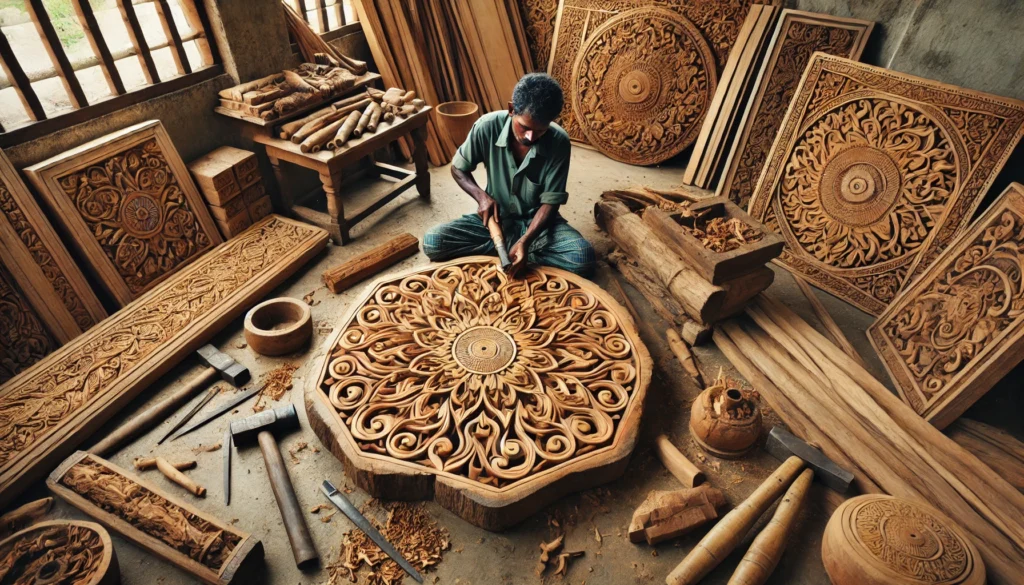DSL Halmilla: A Comprehensive Guide to the Versatile Wood

What is DSL Halmilla?
DSL Halmilla refers to the use of Halmilla wood, a durable and versatile hardwood derived from the tree species Berrya cordifolia. Known for its fine grain and strength, Halmilla is highly sought after in various industries, particularly for furniture-making, construction, and even in traditional Sri Lankan arrack production. Its unique qualities make it an essential resource in many applications, and its cultural significance in Sri Lanka adds to its value.
Botanical Profile of Halmilla
Scientific Classification
- Kingdom: Plantae
- Family: Malvaceae
- Genus: Berrya
- Species: Berrya cordifolia
Physical Description
Halmilla trees are medium to large in size, often reaching heights of 25-30 meters. The leaves are heart-shaped, with a deep green hue, while the flowers are small and pale yellow. The fruit is a small, round capsule, adding to the tree’s distinct appearance.
Geographic Distribution
Native to South Asia, Halmilla is commonly found in Sri Lanka, southern India, and parts of Southeast Asia. In Sri Lanka, it thrives in lowland tropical forests and is often located near water edges.
Historical Significance of Halmilla
Historically, Halmilla has been integral to Sri Lankan culture. It was extensively used in ancient constructions, such as temples and traditional homes, due to its durability and resistance to decay. Artisans have long valued Halmilla for crafting tools, furniture, and decorative pieces, showcasing its versatility.
Characteristics of Halmilla Wood
Physical Properties
Halmilla wood is light yellow to golden brown in color, with a smooth texture and fine grain. It is medium-weight but exceptionally strong, making it suitable for heavy-duty applications.
Mechanical Properties
- Durability: Resistant to rot and insect attacks.
- Workability: Easy to cut, shape, and polish, making it ideal for intricate designs.
- Strength: Its toughness ensures longevity in use.
Comparison with Other Hardwoods
| Property | Halmilla | Teak | Mahogany |
|---|---|---|---|
| Durability | High | Very High | Moderate |
| Workability | Excellent | Good | Excellent |
| Cost | Moderate | High | High |
Applications of DSL Halmilla
Furniture Making
Halmilla is prized for its use in furniture crafting. Its fine grain and ability to hold intricate carvings make it a favorite among artisans. Chairs, tables, and cabinets made from Halmilla exude elegance and durability.
Construction
Builders often use Halmilla for beams, frames, and flooring due to its strength and resistance to moisture. It has been a staple material in Sri Lankan architecture for centuries.
Shipbuilding
Halmilla’s water-resistant properties made it a preferred choice for crafting boats and ships in ancient times. Its ability to withstand harsh conditions ensures long-lasting maritime structures.
Traditional Toolmaking
Halmilla wood is also used to create durable tool handles, showcasing its strength and versatility in everyday applications.
Role of Halmilla in Sri Lankan Arrack Production
One of the most unique uses of Halmilla is in the production of Sri Lankan arrack, a traditional spirit distilled from the sap of coconut flowers. Distilleries utilize Halmilla vats for aging arrack, as the wood imparts a distinct flavor profile to the drink. This method not only enhances the spirit’s quality but also underscores Halmilla’s cultural importance.
Environmental and Economic Importance
Ecological Role
Halmilla trees contribute to local ecosystems by preventing soil erosion and providing habitat for wildlife. Their presence near water bodies ensures ecological balance.
Economic Contribution
Halmilla supports local economies by providing raw materials for industries such as furniture-making and beverage production. It also generates employment opportunities in forestry and artisanal crafts.
Conservation and Sustainability
Current Challenges
Overharvesting and illegal logging pose significant threats to Halmilla’s sustainability. Climate change and habitat destruction further exacerbate the issue.
Efforts in Preservation
- Sustainable Harvesting: Implementing regulated logging practices.
- Reforestation Programs: Planting Halmilla trees in degraded areas.
- Community Involvement: Educating local communities on the importance of conservation.
Conclusion
DSL Halmilla represents a unique intersection of cultural heritage, economic value, and environmental importance. From its use in traditional crafts to its role in modern industries, Halmilla’s versatility underscores its significance. By promoting sustainable practices, we can ensure that this invaluable resource remains available for generations to come.
FAQs about DSL Halmilla
What makes Halmilla wood unique?
Halmilla wood is valued for its fine grain, durability, and resistance to decay, making it suitable for a wide range of applications.
Where can Halmilla trees be found?
Halmilla trees are native to Sri Lanka, southern India, and parts of Southeast Asia, thriving in tropical lowland forests.
How is Halmilla used in arrack production?
Halmilla vats are used to age arrack, enhancing its flavor profile and quality.
What are the conservation efforts for Halmilla?
Efforts include sustainable harvesting, reforestation programs, and community education to prevent overexploitation.
Is Halmilla suitable for eco-friendly industries?
Yes, its durability and natural properties make it ideal for sustainable and eco-friendly applications.
Can Halmilla wood be sustainably sourced for large-scale projects?
Yes, Halmilla wood can be sustainably sourced if proper forestry practices are followed. This includes regulated logging, reforestation efforts, and sourcing from certified sustainable plantations to ensure ecological balance.
How does the aging process in Halmilla vats compare to other woods for spirits?
Halmilla vats impart a unique flavor profile to spirits like Sri Lankan arrack due to their specific chemical composition. Unlike oak or other woods, Halmilla contributes subtle earthy notes and a smooth finish, making it a distinct choice for aging.
Are there any modern innovations using Halmilla wood?
Modern innovations include using Halmilla for eco-friendly furniture and composite materials. Designers are exploring its potential in hybrid products, combining its natural strength with recycled materials for sustainable solutions.
Is Halmilla resistant to termites and other pests?
Yes, Halmilla wood is naturally resistant to termites and other pests. This quality makes it a durable choice for furniture, construction, and outdoor applications, even in tropical climates.
What are the alternatives to Halmilla wood for similar applications?
Alternatives to Halmilla wood include teak, mahogany, and rosewood, which also offer durability and aesthetic appeal. However, each wood has distinct properties, so the choice depends on specific requirements such as cost, availability, and intended use.
Recommended Articles:
- Zerodevices.net: Comprehensive Tech Guide for Smart Gadgets & Solutions
- Radomir Luza Jr Mumia: A Comprehensive Insight into Art and Advocacy
- Çeciir: The Ultimate Guide to Chickpea Cuisine, Nutrition, and Recipes
- How TraceLoans Transforms Lives and Businesses: The Ultimate Guide
- WWE SmackDown Episode 1491: A Night of Surprises and Championship Drama







